Roof beam detail from a traditional fortress structure built during the Joseon dynasty.

Seoul at night:

Last night, I had the best duk-boki I've eaten in my life, and that's no exaggeration. Made by an aujuma ("elder, un-related woman") at a food cart on the street near the EWHA campus. Wow it was so good...
Soft, swollen-finger sized, steamed rice cakes, stewed in fermented red pepper paste (koche jang) with the occassional sesame leaf for perfume and fishcake for counter-balance. The rice cakes are very, very slightly sweet (as is the essence of Korean rice), and the koche jang is pungent and somewhat eye-watering.
YUMMY!
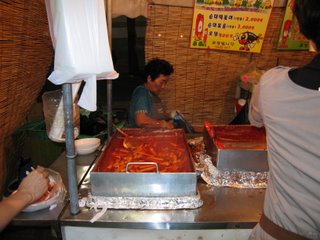

It's the epitome of street food and comfort food. One can commandeer a generous portion for about $2USD in any neighborhood where there is pedestrian traffic and therefore food carts at night. (Allistar, you would have loved it!)
(I think this is turning into a food blog hee hee.)
Some observations about Korea:
1. Koreans love order and harmony. Upon exiting the subway platform for the escalator during crowded, rush hour conditions, spontaneously commuters form a single line and everyone boards the escalator on the right side (leaving the left open for those who wished to walk ahead of those on the right who chose to ride without exertion) with exactly 1 step between each person. I looked ahead and behind me and for all the people I could see on this long escalator, and could see no one in violatation of this unspoken 1-step-in-between "rule". It's uncanny.
And it's not a politeness or personal space issue either, as I have been shoved, elbowed and unceremoniously bumped with no acknowledgement or apology on crowded streets, in stores and in subway cars.
2. Korean customer service is like none-other. Attentive and not overbearing, as soon as you walk into any establishment of any type, you are greeted, often with a smiling bow and a hello. When you enter a parking lot, people are stationed next to the ticket-generating machine to bow, hand you your ticket, and say hello and welcome (on a microphone, the wireless kind performers wear when they dance and sing on stage). Further into the parking lot, attendents are stationed to point with hand and body gestures the next closest/available space. I believe their moves are choreographed. (I can't help think these people must be miserable in an exhaust-filled garage wearing formal uniforms, hotel-bellhop-type garb complete with cap, on a hot/humid day made all the worse by the heat of the car engines.)
3. The Korean Metro subway system is world-class. It is far-superior to the New York City subway system (or Chicago or any U.S. city for that matter): it's convenient, cheap & clean! It must be one of the best in the world. It's extensive in distance and yet dense, so that you can get to the far suburbs quite easily (as an extension of the Seoul subway) as well as conveniently move around Seoul. The trains to these further destinations run more frequently than our equivalent (Metro North or NJ Transit) and are a lot less expensive ($1.50 USD to go the equivalent distance of Long Island).
The subways are clean, not only the interiors of the cars but the stations themselves. The underground stations have enclosed train tracks with sliding doors for going onto or off of the train to the platform (so no disgusting subway odor). The subway cars are much wider with overhead luggage racks, and you can select your preferred environmental conditions based on selecting the car you enter -- full airconditioning or lightly airconditioned or lightly heated, etc., you pick. Stations passageways and platforms are airconditioned too! There are electronic signs and correct-volume modulated announcements in each car and at each station (in Korean and English). There is not one piece of trash in any subway car, and people occasionally leave newspapers on the overhead racks for the next person (but as below, no one reads them anyway).
One major caveat: the subways in Seoul do not operate between 12:00am - 6:00am. What were they thinking??!?
4. In addition to a world-class subway, Korea has world-class public toilets. I'm not kidding. They are western-style, and they are spotless. They are sufficient in number (never a worry of finding one). But that's not all the amenities -- for example, the ones in the Chulwon post office (further north, close to the DMZ), had heating for the seats (should you find yourself on a cold day with a cold butt). Some have sound-generators for modesty (classical music, the sound of a stream of water, etc.), so you can do your business without others hearing your bodily noises nor you hearing others' noises for that matter.
I ran into a little problem the other day. In a restaurant bathroom stall, I found myself faced with so many electronic buttons on the toilet console and no clue which was the correct one for flushing the toilet. Well, I pushed the one that looked most obvious to me (larger in size, red in color, located toward the top of the set of buttons), and the next thing I know, a stream of water from a separate nozzle starts shooting outward. I had to cower into the corner of the stall to avoid that impromptu shower and fumble to figure out how to stop the clean water supply. As I was with esteemed family members, people in front of whom I did not want to embarrass myself nor cause attention to my gaffe, I dried my shirt as best I could and maneuvered myself back to the table in hopes no one would take notice. (If they did notice, no one said anything -- phew!)
5. Korea is one of the safest countries on the planet. Korea has little violent personal crime and very low rates of property crime. As with many countries, strict gun and weapons control laws mean guns are rare to non-existent among the citizenry with no major industries profiting from the proliferation of weapons. And Korea has nothing like the neanderthal, oppressive customs that are still widespread in some other countries (even with strict gun control laws) -- those that lead to stonings of unmarried lovers or dowry-murders, or physical or sexual violence toward female family members of criminals or vigilante violence, etc. I'm not saying there is no violent crime here in Korea, but it is practically nil.
It's so refreshing to read the newspaper and not be bombarded with the stories about this attack, that rape and the other murder...instead most of the crime-related stories are about white collar crime and corruption.
Even property crime (widespread in other countries where it is relatively safe, such as across Western Europe) rates are very low in Korea. It's not unusual for people to leave a briefcase or purse unattended for a minute or two on a subway or in a crowded restaurant. One morning in Gyeongju, I walked into a souvenir shop -- doors were unlocked and I thought this meant it was open. Then I noticed the lights were out and no one came when I called. Though no phenomenal customer service can be had when people are still asleep (wink!), clearly no one was concerned that the souvenirs would walk away on their own accord.
It's not unusual when I travel that I feel safer than when I am in the U.S. (due to many other countries having low rates of violent crime or personal crime compared to the U.S.) but this is an extreme -- one to which I am trying to avoid becoming accustomed as I know I face varied conditions elsewhere.
6. The food in Korea is higher quality and much less expensive -- in Seoul, half to one-third the cost compared to NYC and fresh and varied.
That being said, America chain restaurants are ubiqitous in Seoul (but not necessarily outnumbering Korean establishments) -- not only McDonalds, Burger King and KFC, but Starbucks, Krispy Kreme, Dunkin' Donuts, Outback...and many more. [[And I've only been to Starbucks 3 times in 3 weeks! As for the rest of that stuff, I take a pass!]]
7. Koreans are relatively religious -- mostly Protestant. The Methodist is the largest denomination followed by Lutheran. At the same time, Confucianism, Taoism and Buddhism are respected and play an important role in daily life. Korea is unlike other cultures for which choosing one religion (often) mandates the proactive rejection of all other religions and systems of belief.
Protestantism in Korea has the historical roots in Korean resistance of the Japanese occupation -- which is one of the reasons why Christianity is more predominant in Korea than in any other Asian country. To quash the resistance, the Japanese forbade public gatherings, but Koreans in organized religious gatherings were able to skirt around this rule and thus meet for dual purposes. (Unfortunately, eventually the Japanese caught on, so some of the infamous massacres during the occupation were of people attending church services.) So, that is one of the culturo-political reasons why religion in so important in Korea.
8. Koreans are very, very chaste. Passion and sex are not that important in life. There are many couples of all ages (not necessarily married), but coupling seems to be more about companionship. I'm sure there is a dark side here (as elsewhere, everywhere) and exceptions, but for example, one of my cousins (a middle cousin like me, who is female and close in age to myself) gets embarrassed by very "romantic" wording in American pop songs of the 80's. (which of course doesn't compare in that regard to "music" these days!) This is one of the culture shocks (or perhaps re-adjustment) compared to the over-sexualization of everything commercial/American.
9. Koreans are crazy-in-love with their cell phones (or as they call them here in transliteration: "han-de-pone"). For example on the subway, among a set of seats of 12 people, 10 or 11 of them (of varied ages) will be talking on it (yes, they work in the subway system!), texting, playing games on it or just gazing at it. I too am a geek for electronic goods, but here it seems overboard. Rarely do I see anyone on the subway reading (which is the norm in NYC).
That being said, when people speak on their hand phone, it's not disturbingly loud and overbearing, the way I'm sure it would be if cell phones worked on the NYC subway.
***
I hope everyone is enjoying the last few lazy weeks before autumn and that infectious energy and buoyant drive which characterizes that time of year (and makes me miss New York City!)

 The views were sublime.
The views were sublime.

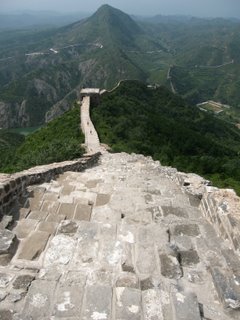













 A luminescent sky upon leaving the museum:
A luminescent sky upon leaving the museum:






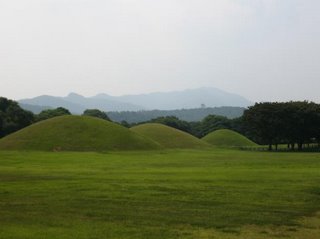
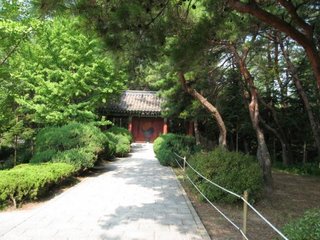






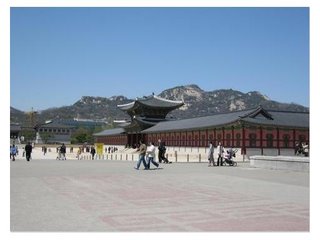
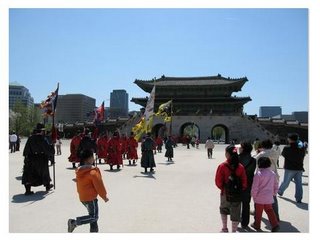
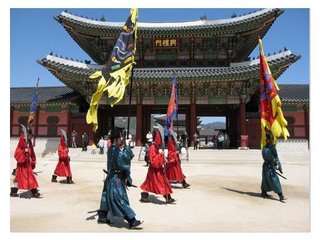

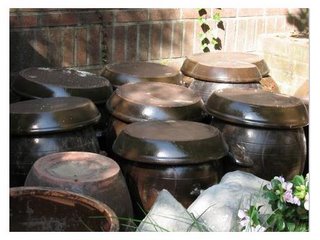
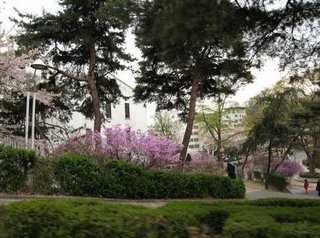 UPDATED PICS HERE! The campus has a mix of modern buildings...
UPDATED PICS HERE! The campus has a mix of modern buildings...

 This is the final hill of 4 major ones to the dorm:
This is the final hill of 4 major ones to the dorm:

